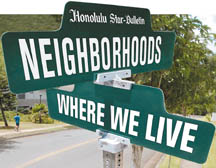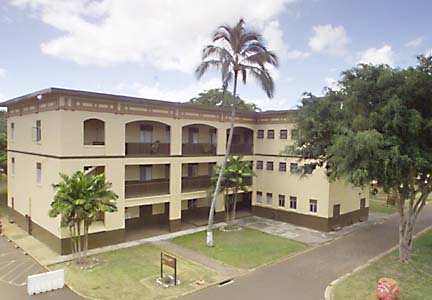
Military communities cover tens of thousands of acres on Oahu and are home to just as many people who stand largely insulated from the rest of the island's people.
Yet, their presence affects all aspects of life here, and many come back to Hawaii after leaving service.
The federal money funneled through the installations through construction and individual spending boosts the economy. Schofield Barracks will be the scene of a housing renovation project that will provide a welcome dose of federal funds as the Army hopes a nice place to live will be an incentive for retaining and recruiting its troops.
Schofield Barracks | Marine Corps Base Kaneohe
BACK TO TOP |
DENNIS ODA / DODA@STARBULLETIN.COM
D Quad at Schofield Barracks is one of the self-contained Army units of three barracks and one administration building surrounding a central courtyard.
Army will improve
housing on the postProviding secure and private
homes is the best way to retain
troops, the service says
During the next decade, the Pentagon will undertake a housing project in Central Oahu that reflects the changing face of the Army -- soldiers with families.
Schofield Barracks, named after a former commanding general of the Army, John Schofield, is the largest Army post in Hawaii. As early as 1872, Schofield advocated the need for the United States to annex Hawaii because of its strategic military value.
Following annexation, 14,400 acres on former Hawaiian crown lands between Oahu's two mountain ranges was ceded to the U.S. government on July 26, 1899. By 1908, construction on a major military post was begun, and a year later it was named after Schofield.
When the U.S. War Department formed the Hawaiian Department in 1913, there were just 6,000 soldiers, most of them single, assigned to the post.
Today, Schofield, with two brigades of the 25th Infantry Division and other supporting units at Wheeler Army Airfield and Helemano Military Reservation, is the home of more than 21,000 soldiers and dependents.
With upward of 11,000 soldiers married, the Army says housing that is secure and private ranks as the most important factor to keep the soldiers enlisted.
With that in mind, the Army began a building program in August that calls upon private-sector capital and expertise to build, operate and manage military family housing. The Army wants to convert all of its 7,700 housing units on Oahu, 3,336 at Schofield, during the next five years. The Army says that during the next half-century it will have invested nearly $7 billion to ensure a better life for its soldiers here.
Capt. Kathy Turner, 25th Infantry Division spokeswoman, said Schofield Barracks is fairly isolated. "Unlike Fort Drum in New York, where relatives can easily drive to them when a soldier or his family needs help, soldiers and their families here have to rely on each other."
Steve Takekawa, chief of business operations at Schofield, notes that with 7,000 25th Division soldiers scheduled to be sent to Afghanistan next year, "we are looking at ways to take care of the family members who are left behind." Programs such as live videoconferencing sessions with families and soldiers in Afghanistan are being planned.
Throughout the past century, the population of the Army post has reflected the country's military vision of the Pacific, climbing to as high as 14,000 soldiers before the Japanese attack on Pearl Harbor in 1941 and dipping to as low as 2,000 in the years following World War II.
Lt. Col. Jay Hammer, operations officer for U.S. Army Garrison Hawaii, notes that five of the Wahiawa Army post's nine "quads" are listed on the National Register of Historic Places.
"Quads" were self-contained Army units of three barracks and one administration building surrounding a central courtyard built beginning in the early 1900s.
BACK TO TOP |
CRAIG T. KOJIMA / CKOJIMA@STARBULLETIN.COM
James and Courtney Davis say they sometimes leave the base to do "touristy" things like going to a luau.
Home amid helicopters
and Humvees
The Marine Corps base in Kaneohe, nearly surrounded by beaches on Mokapu Peninsula, is almost an island on its own.
"It's like a small city. It's got everything," said Courtney Davis.
The 2,951-acre Marine Corps Base Hawaii is home to 16,000 people.
"You really don't have to leave if you don't want to," she said, adding that her family goes off base only once a week to do "touristy things" like the swap meet, Hawaiian Waters Adventure Park or the Paradise Cove luau.
Davis, a stay-at-home mom, lives in a two-story townhouse on base with her husband, James, 25, who is a sergeant in the Marines, and their two children, Alexis, 3, and Jacob, 9. Their house, where the family has lived for eight months, stands at the end of a cul-de-sac on Faleafine Place and has a big back yard that opens to a sandy beach where James and Jacob often fish for sea creatures to fill their 55-gallon fish tank.
The base has everything the family needs: restaurants, beaches, a shopping mall, bowling alley, golf course, movie theater and even a public school. Jacob attends Mokapu Elementary School, about a mile from his house.
The Davis family lives like many other families in Hawaii, but their life is made unusual by being inside a military base.
CRAIG T. KOJIMA / CKOJIMA@STARBULLETIN.COM
Sgt. James Davis and son Jacob check out a cowry shell in their saltwater aquarium.
When Jacob rides his bike to school every day, he sometimes sees military planes and helicopters flying above and Humvees on the roads transporting large weapons.
"But they don't bother me at all. They're pretty cool," he said.
Less than a mile from the Davis home is a rifle range inside a crater where the military, FBI and Honolulu Police Department train. A dozen CH-53 Sea Stallions, or heavy-lift helicopters, rest near the dock where Marines and their families rent kayaks, surfboards and snorkel gear.
Across the flight line where planes take off and land lies the best beach for fishing, said Jacob, who has already collected more than 20 sea animals, such as rock fish, flounder, shrimp and crabs.
But the weapons, Humvees and Sea Stallions don't intimidate Davis. If anything, Davis said she feels safer knowing the artillery and aircraft are close to home.
Her husband, who is often away from home and was most recently deployed to Thailand for a month, agreed.
"There's a lot more sense of security on base. When I leave, I'm not really worried about her because she's here," James Davis said. "It's a relief knowing my family is safe."






